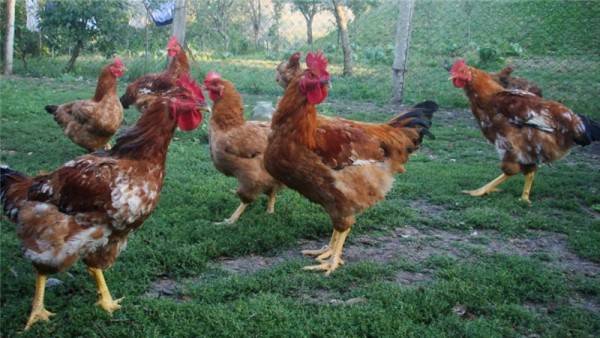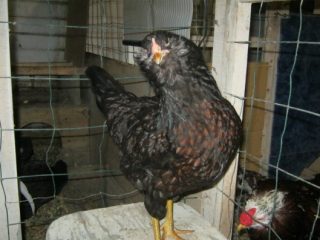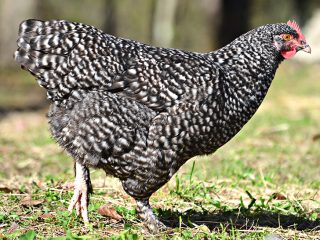Content
One of the universal chicken crosses, intended for breeding by small farmers and private farmsteads, was bred in Hungary and, despite the advertising of sellers, is still little known both in Ukraine and in Russia. However, the cross is very similar to egg Red Bro and Loman brown. Perhaps the chickens are simply confused.
Foxy chick chickens, whose name literally means “fox-colored chicken” or “fox chicken,” got their name not from their friendly relationship with the fox, but from the color of their feathers. The true color of these hens is dark red, although slightly different from the more common brown egg crosses like Loman Brown. The photo shows a cross foxy chick with a small amount of feathers of a different color.
After the cross was brought to Ukraine, these chickens received the additional names “Hungarian giant” and “red broiler”. These same names migrated to Russia. In general, cross breeds are rarely bred anywhere, so you should be very careful when purchasing chickens of this breed or hatching eggs. For example, it is impossible to say with certainty whether the chickens are Foxy or another “red” breed captured in this photo.
Attempts by private owners to buy any purebred bird have shown that the sale of chickens is often carried out by resellers who themselves have little understanding of who they are selling. They just don't care.
Therefore, if you want to have real foxy chicks, you need to look for a proven breeding farm, perhaps based on recommendations. It is not worth buying chickens from an advertisement from private hands, since the foxy chick is a hybrid, the parent breeds are traditionally kept secret by the manufacturer, and purebred breeding of this cross by private owners is impossible.
At best, they can sell a cross with Orlington red roosters or Rhode Island red roosters. Chickens from Foxy Chick hens and these roosters are very similar to the cross, but in terms of productive characteristics they are inferior to the cross.
Foxy Chick. Pros and cons of this cross
Description and characteristics of the Foxy Chick chicken breed
Foxy Chicks are large chickens that gain up to 4 kg of weight with the right diet. Roosters can grow up to 6 kg. Foxies grow slower than broiler breeds, but their cultivation pays off because the chickens are suitable for both meat and eggs.
Foxies gain weight very well, although they are inferior to broilers in daily weight gain. At 4 weeks, the average weight of chickens is 690 g, and at 50 days, chickens weigh on average 1.7 kg. The egg production of chickens of this breed is 300 eggs per year. The eggs are large, weighing 65 - 70 g. The shell color is light brown.
The standard indicates that the foxy is a squat, wide-bodied chicken with a powerful body. The description of the breed is true, but only for adult birds. Chicks first grow in length and only then their bodies begin to expand. Moreover, the young animals are so different from the description that the owners mistake them for some other breed.
The breed was bred specifically for private owners and local farmers, so there is usually no question of what to feed Foxy. Unlike broiler and egg crosses, which require specialized feed to obtain the result declared by the seller, foxy can get by with the same feed as regular domestic layers.
Growing Cobb 500 and Foxy Chick broilers. Comparison
And just like other chickens for private backyards, foxy needs greenery.
A serious advantage of the Foxy Chick cross is the 100% survival rate of hatched chicks. Of course, if you don't put a bucket of water directly on them. This makes Foxies stand out from other breeds of chickens and chicken crosses. Especially from broilers, which have a high mortality rate among chickens.
Foxy is a rather quarrelsome bird, starting fights even among themselves. When keeping a cross at home, you cannot leave more than one rooster in the flock. Even chickens are characterized by increased pugnacity. When kept with other breeds of Foxy Chick chickens, the “outsiders” are simply slaughtered, taking advantage of their size and weight advantage.
Contents foxy
The cross is undemanding to living conditions, but is poorly adapted to the Russian cold. Of course, like all land birds, it does not like dampness and rain, so for winter roosts and inclement weather in the fall and spring it needs shelter in the form of a barn. Chickens are afraid of drafts, so the barn should have no gaps.
If chickens are kept crowded indoors, they may develop lice bugs. To prevent infection with this parasite, chickens should be given a box with sand or ash. Moreover, ash in this case will be better.
The winter bedding should be deep enough so that the birds can “equip” a hole there for themselves, which will be warmer than in the barn. There is no need to insulate the shed if the temperature in winter is not too low. But, if possible, it is better to insulate the room.
This breed also needs perches, since, despite their considerable weight, Hungarian giants fly well. This, by the way, must be taken into account when constructing enclosures for walking. It is better to make perches at a height of 40–80 cm.
Cross breeding
The very concept of “cross” already excludes the possibility of breeding, since in the second generation there will be splitting into the original breeds. Moreover, since the inheritance of genes of highly organized organisms is complex, the offspring will have an arbitrary mixture of characteristics of the parent breeds. As a result, the second generation hybrids will be significantly inferior in their productive characteristics to the Foxy Chick cross.
Hatching and hatching chickens is not about chickens of any of the specially bred crosses. To obtain eggs, birds need to be equipped with nesting boxes, and chicks will have to be hatched in an incubator.
You can come across claims that foxy are good hens. To understand that in these chickens the brooding instinct is completely absent or poorly developed, it is enough to check the productive characteristics. No hen that lays more than 200 eggs a year can be a good broody hen. She doesn’t have time for this, since she has to lay the eggs and molt them.
Thus, a chicken lays 20-30 eggs, incubates them for 21 days, then begins to lay eggs and incubate again, making 3-4 clutches per season, and “goes” to molt, eventually laying no more than 150 eggs per year.Second option: the chicken lays 300 eggs per year, leaving 2 months for molting. But in this case she does not incubate.
You can try to breed a foxy using an incubator if you add a rooster to them not of a similar breed, but of an Orlington or Rhode Island. In the first case, the offspring will retain their size, in the second, egg production.
Feeding young and adult birds
An adult bird is fed in the same way as chickens of other breeds. Young animals are usually fed broiler starter feed. Free access to fresh water is required, as dry feed can get stuck in the esophagus.
You can also feed homemade high protein feeds by mixing boiled eggs, semolina, baker's yeast and green grass. You can also add dairy products.
But you need to keep in mind that all such homemade food quickly deteriorates. In addition, they are made by eye and it is impossible to determine the content of microelements and vitamins in such food.
In contrast to homemade food, industrial food is made according to instructions and there are fewer surprises with it.
Reviews from rare owners of the Hungarian giant
Cross foxy chick is not very common in Russia and a little more common in Ukraine. Nevertheless, there are those who acquired these chickens.
Conclusion
Cross Foxy Chick is a very convenient type of hybrid to keep in your own backyard. But due to the growing popularity and small number of real Hungarian giants, it is easy to buy a chicken of unknown origin, so it is still not worth buying this cross through private advertisements on websites.
















I bought eggs from a woman on her private farmstead.
Foxy chick hatched perfectly.
By the appearance of some of the individuals, it is clear that a certain “well done” with a bare neck came into the chicken yard to visit the Foxy Chick chickens. There were two of these for 34 individuals.
They grow beautifully. Not a single one died (pah-pah...).
Large ones.
And contrary to the opinion expressed in the article, PEACE LOVERS!
They live with the Leghorns. These are the ones... give heat to each other and to the Foxies. All the butts were plucked. Fought.
I will cross with Orpinkton.